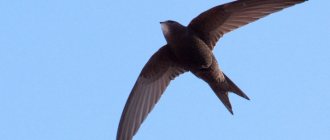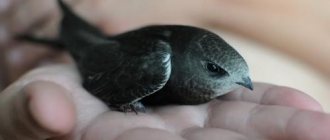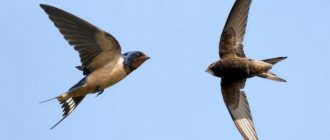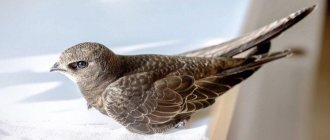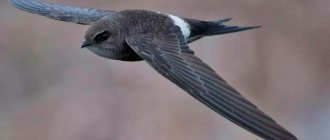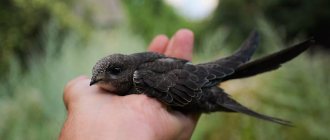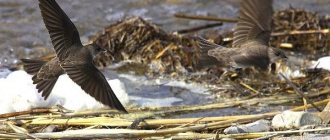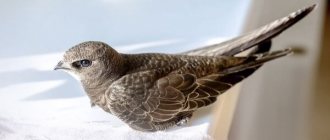| Latin name: | Apodidae |
| English name: | To be confirmed |
| Kingdom: | Animals |
| Type: | Chordata |
| Class: | Birds |
| Squad: | Swift-shaped |
| Family: | Swifts |
| Genus: | To be confirmed |
| Body length: | 16–22 cm |
| Wing length: | 15-18 cm |
| Wingspan: | 42-60 cm |
| Weight: | 25—140 g |
Description of the bird
A swift bird in a person's hand
A swift is a small bird, mostly gray in color with black and white splashes. Externally, the swift looks a little like a swallow. The body length of the bird is from 10 to 12 cm, the weight of adults is about 140 g. The head is large, the beak is sharp and small, the tail is straight, the wings are curved, long, the legs are weak and short. Rainbow is black.
— Advertising —
Relative to the body, the swift has very short legs, so if the bird is on the ground, then when it tries to take off, its long wings hit the surface of the ground and make it difficult to take off.
The plumage of males and females is the same, monochromatic, dark, occasionally with a metallic tint.
The swift's flight is characterized by very high speeds; some species are capable of reaching speeds of up to 120 km/h and higher. Swifts also have an unstable body temperature, like most species of birds, so in the event of a sharp cold snap, swifts fall into torpor, a short hibernation.
Features of the swift's flight
A distinctive feature of all swifts is their speed. The Apus apus we are considering is capable of accelerating in the air up to 111 km/h and this, by the way, is not the limit (the needle-tailed relatives of the black swift reach a speed of 170-180 km/h). For comparison: the same swallows fly no more than 60 km in an hour.
It is interesting that swifts fly not only quickly (without slowing down even before approaching the nest), but also for a long time. This amazing bird even has the ability to sleep in the sky, catching the rising air current and only from time to time slightly swaying its wings right in its sleep.
Takeoff
Swifts have very short small legs and a large wingspan relative to the body. Therefore, they practically cannot take off from a flat horizontal surface - the wings simply hit the plane. They definitely need a little elevation.
Maneuverability
The maneuverability of swifts ensures their amazing ability to use their wings asynchronously. As long as one wing moves faster than the other, the bird is able to take the sharpest turns without slowing down.
What does it eat?
The swift flies with its beak open
– Advertisement –
The basis of the swifts' diet is insects flying in the air. Therefore, both the diet and lifestyle of these birds are closely related to weather conditions. For example, when insects disappear due to the onset of cold weather, swifts change their place of residence - they go nomadic in search of food.
When swifts are hungry, their body temperature drops significantly, which ends in hibernation, or “trance sleep.” Thanks to this adaptive adaptation of the body, swifts are able to survive hunger from one to ten days. Using “trance sleep,” little chicks wait for their parents when they fly long distances in search of food.
Enemies and other troubles
Thanks to its ability to fly, the swift has no permanent enemies, except for one pest. The cavity mite can penetrate the body of both adults and young individuals and cause serious diseases: from skin dermatitis to paralysis of the limbs.
Birds living within the city often become victims of cats. In the wild, there have occasionally been cases when swifts encountered birds of prey, in the fight against which they died. Situations have also been recorded where entire colonies were killed by a raid on high-voltage transmission lines.
To this day, birds do not trust people. This is most likely due to the fact that at the end of the 19th century we hunted chicks, considering their meat to be a delicacy.
Where does it live?
Swifts can be seen in almost every corner of the planet. The bird is not found only in very cold climatic zones. Swifts live both in forest areas and in open areas.
Mostly swifts like to live in big cities or on coastal cliffs, where it is convenient for birds to build nests. Swifts live in large flocks. Large colonies of these birds, consisting of several thousand pairs of swifts, can be seen in cities or in the mountains.
Among the numerous species of swifts, a distinction is made between sedentary and migratory populations. But in any case, the activity of these birds does not decrease from morning to evening.
Swifts spend almost all their time in flight; birds devote only a couple of night hours to sleep. The swifts' flying machine is almost perfect, and allows them to travel hundreds of kilometers. It seems that swifts do not know fatigue.
Lifestyle
The swift is a bird that lives in colonies. This makes it much easier for birds to monitor the world around them and notice danger in time. This bird is very dependent on the environment, weather and temperature conditions.
Important!
If a bird cannot find food for some time, its body temperature drops to 20 degrees, and it falls into a slight stupor. This state is necessary for the animal, because this way it can control and reduce energy consumption, of which the swift has little left anyway. This often happens in cold weather, when finding food becomes problematic.
The bird can spend several days in this state until weather conditions improve. Even chicks are capable of falling into such “hibernation,” but for a completely different purpose.
In this state, they wait for their parents, who are looking for food. Chicks can wait for their parents in a state of torpor for up to 9 days without noticeable problems. In general, swifts are active from morning until evening.
Migration of birds for wintering usually occurs in August, but here also much depends on weather conditions.
So, if the conditions in which the bird lives suit it, and it can exist like this until next year, then you should not wait for its migration.
That is why many swifts that have settled within the city can live here permanently without changing their registration for the winter period.
The heat from city transport and from the illumination of shops helps warm the air and thereby makes life comfortable for birds in an urban environment.
The swift's diet consists of numerous insects, which the bird can catch on the fly.
Important!
The nature of birds can be called hot-tempered rather than cunning or cautious. You can often see birds from this family getting into fights with their fellows or other birds, and the fight can be very serious. The swift may even forget about his safety and completely succumb to the impulse - at this moment his behavior resembles the hot-tempered character of a brawler.
In flight, there is almost no threat to the swift, because it is the leader in speed. And only a falcon of prey, which, when falling, develops a speed greater than that of a swift, can consider this small bird its prey, although this does not happen so often.
Common types
Black or tower swift (Apus apus)
Black or tower swift
The bird reaches 18 cm in length, the wingspan is about 40 cm, the wing length is approximately 17 cm, the tail is 8 cm long. The bird's physique resembles a swallow. The tail is forked. The plumage color is dark brown with a greenish metallic sheen. The chin and neck are decorated with a white round spot. The iris is dark brown, the beak is black, the legs are light brown. The plumage of males and females is the same. The chicks are lighter than the adults, and their feathers have off-white edges at the tips. In summer, the black swift fades noticeably, and in general its plumage becomes much lighter.
The horizontal flight speed of the black swift reaches 111 km/h.
The species' habitat includes central Europe, northern and central Asia. In Russia, the bird is distributed from the western borders to Transbaikalia. Lives mainly in cities.
The black swift's wintering grounds are located in Africa and southern India. On their way, the birds fly across the entire continent from north to south. This species also winters in southeast Asia, in Thailand.
White-bellied Swift (Tachymarptis melba)
White-bellied swift in the sky
The body shape is streamlined, oblong, the wings are long and pointed. The tail is forked. The bird's body length is from 20 to 23 cm, the wingspan is 51-58 cm, the weight of adults is from 76 to 125 g. Females are slightly smaller in size than males.
The neck and top of the belly are pure white, there is a dark stripe on the chest. The underparts and upperparts are beige or gray-brown. The beak is black, the iris is brown-black. The paws are beige, the tips of the toes are dark brown with black claws.
The species is distributed in North Africa, Madagascar, southern Europe, central Europe, Western Asia, central Asia, India and Sri Lanka.
White-rumped or white-rumped swift (Apus pacificus)
A white-rumped swift flies over the sea.
The bird lives in eastern Asia. The species is migratory, migrating to south-east Asia and Australia for the winter. In addition to Asia, it was registered in the USA, New Zealand, and Europe (Denmark, Spain, Sweden, Great Britain). In body shape and plumage color it resembles a common swift, but differs from it in the white rump stripe. Females and males do not differ from each other; in young birds, the edges of feathers may be pale. The voice is screeching.
Pallid swift (Apus pallidus)
Pale swift
The bird's body length is 16-18 cm, weight ranges from 32 to 44 g. The tail is short and forked. The body is torpedo-shaped. The wings are long and sickle-shaped. The length of the wings is from 16.5 to 18 cm, the beak is small, about 0.5 cm long.
The pale swift is similar in appearance to the black swift. But his body is stockier, his plumage is generally lighter, and his belly is brownish. Against the background of the rest of the plumage, a white spot in the throat area stands out in contrast. The cry is piercing, high-pitched, and consists of a two-syllable “vri-e.”
The habitat of the species is North Africa, Southern Europe and the Middle East. It appears extremely rarely in Central Europe. The bird is migratory and migrates to tropical Africa for the winter.
Habitats
Swifts can easily fly from place to place. Even long distances are not significant for these birds.
A lot of them live in the western regions of China and Siberia, as well as in Spain. This bird also lives in more northern areas, for example, in Finland, Norway and the subarctic zone of Russia. They are found among.
They also love southern regions, for example, Turkey, Algeria, Lebanon, Morocco, Israel.
The breeding area of this bird can cover the whole of Europe and Central Asia. No settlements of swifts have been observed in India, Korea, Australia and most of China.
These birds live quite well on the equator, and for the winter they like to settle in the southern regions of Africa.
Reproduction
Swifts in the nest
In spring, migratory swifts return to their former habitats. They have an excellent memory, and the birds are very attached to nesting sites. As soon as they return, the swifts immediately begin building their nests and laying eggs. A female swift usually has 2 eggs in one clutch. The black swift has 4 of them. The female does incubation for two to three weeks. During this period, the male provides food for both himself and his spouse. After the chicks are born, they remain under the care of their parents for about 40 days, after which they leave the nest forever. The average lifespan of swifts is from 10 to 20 years.
Chicks
Swifts hatch two or three eggs at a time. Both the female and the male incubate them for fourteen days. This time varies depending on the weather and therefore the ability to hunt. In the event of completely unfavorable weather conditions, parents may abandon the nest, losing the opportunity to breed offspring this year.
Grown-up chicks fly out of the nest a month after birth, but if the weather is not favorable, they may linger for two. As soon as the young leave the nest, they begin an independent life.
Interesting Facts
Swift bird sitting on the fence
- Swifts are capable of reaching speeds of up to 170 km/h; they are real champions of high-speed flight among birds. For example, a swallow flies at a speed of 70 to 80 km/h. But at the same time, swifts can only fly. They cannot swim or walk because their legs are too small for this. When a swift finds itself on the ground, it is difficult for it to take off due to its large wingspan.
- To rise into the air, a swift needs a springboard or a hill. Therefore, swifts spend most of their lives in flight: looking for food, eating, drinking, obtaining building materials for the nest, and even mating. Moreover, these birds can even sleep in flight for several hours, occasionally flapping their wings.
- Some types of swifts build nests from saliva, which hardens in the air, they are called “swallow’s nests”, from which they cook the most delicious soup in the world that people eat.
Weather apocalypse in Moscow: stormy winds, thunderstorms and downpours. September 17, 2022
Show description An active cold front struck the Capital Region on Thursday, September 17, 2022. In Moscow and the Moscow region there were thunderstorms with heavy downpours and powerful squalls. The maximum wind speed at the region's weather stations reached 28 m/s! In some areas, up to 40 mm of precipitation fell, which is almost 2/3 of the September norm. Many trees have been knocked down, many cars have been damaged, and underground passages are again flooded. It became sharply cold: before the front approached, the air managed to warm up to +22, and then the temperature dropped to +10. Three victims are already known. The bus stop in Solnechnogorsk was crushed. Two people were taken to hospital with injuries. There is record congestion on highways. Their score is close to the maximum 10 points.. You can find out the latest and accurate weather forecasts, as well as interesting information about weather and nature on my pages on social networks: VKontakte: https://vk.com/public176065030. Facebook: https://www.facebook.com/LeusMikhail. Instagram: https://www.instagram.com/weatherlocator. Twitter: https://twitter.com/WeatherOfMoscow
Video taken from the channel: Weather from the Chef
